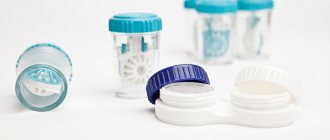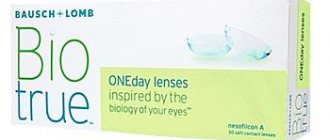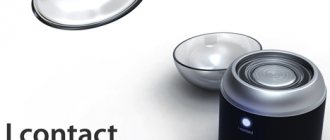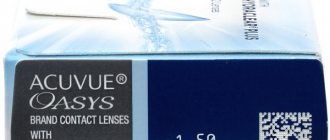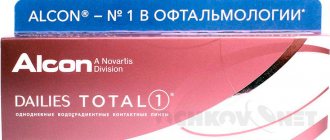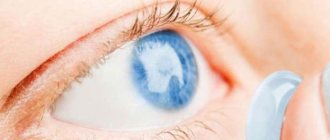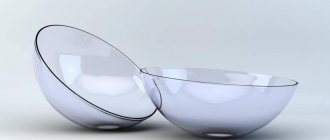If previously vision problems occurred mainly in older people, now this has seriously affected young people and children, even the smallest. And the point here is not so much in heredity, but in our careless attitude towards our eyes.
Correcting this situation must begin with a visit to the doctor. Self-medication is absolutely inappropriate here. Depending on the complexity of the situation, the specialist will offer options for solving it: surgery, glasses or contact lenses. The latter will be discussed today.
Contact lenses are small, cup-shaped lenses with optical properties that are placed directly on the eyeball. They are among those medical products that cannot be selected independently, and it is strictly forbidden to do so. And all because there are a great many of them, and it is very difficult to understand their properties yourself.
Who needs contact lenses and why?
Modern breathable materials, a wide optical range, and the latest technologies enable a person to restore the quality of vision. It is recommended to opt for contact optics for the following diseases:
- Presbyopia is an age-related change.
- Astigmatism is a violation of the shape of the lens and cornea.
- Hypermetropia is farsightedness.
- Myopia of varying degrees - myopia.
If the selection is made correctly, the basic characteristics of a person are taken into account, the lenses become part of the integral system of the visual organ. Vision will be good.
Among the main advantages are:
- No restrictions on the field of view, which cannot be said about glasses.
- Possibility of use if a person plays different sports.
- They are not affected by various weather factors, for example, rain, snow.
- Ideal for people with strong range differences between the right and left eyes.
Types of contact lenses
A huge number of optics are produced, classified according to different criteria. To choose the best option, it is advisable to know all the features.
Wearing mode:
- Daytime - used during the day, you need to remove it before going to bed.
- Prolonged - used from one to seven days.
- Classification by material involves division into hard and soft.
Based on the time of replacement, they are divided into:
- Period.
- One-day.
- For two weeks.
- Quarterly.
- Traditional, which can be used for a period of six to nine months.
By design type:
- Toric - can simultaneously correct both myopia and farsightedness; used for astigmatism.
- Aspherical - the surface has the shape of an ellipse. Even at high diopters they do not distort, unlike round ones. They have a large viewing radius, are thinner, lighter, and flatter.
- Spherical – I have a regular, round shape; The group includes most of the classic product models.
- Multifocal - due to the presence of several zones of different levels of optical power, they provide clear vision at near, medium and long distances.
- Color contact lenses.
Do not try to choose eyepieces in which your vision will be perfect, especially if you often have to work at a computer. Thanks to the lens being located directly on the eyeball, you will see better than with glasses with the same optical power.
Contact lenses also have a number of special medical indications:
- myopia and hyperopia of high degrees. Lenses allow you to achieve significantly higher levels of visual acuity and quality than glasses.
- intolerance or dissatisfaction with the results of spectacle vision correction.
- a large difference (more than 2.5 diopters) in visual acuity of the right and left eyes. In this situation, glasses do not allow one hundred percent correction;
- aphakia (absence of the lens) after removal of a cataract, injury or congenital eye defect;
- vision correction for amblyopia (“lazy eye”) - decreased vision for no apparent reason.
In addition, soft contact lenses are prescribed for professional indications to athletes, doctors, construction workers, etc. Contact lenses can also be used to change eye color for cosmetic purposes.
Materials for making contact lenses
The comfort of wearing them and the need for getting used to them depend on the material from which the products are made. Today, soft lenses are more often recommended. Special polymers are used for their production.
Hydrogel contact lenses provide a high level of wear due to their softness and thinness. They are very popular. Low gas permeability is offset by a high content of water, which conducts oxygen molecules to the cornea. When choosing optics, you need to focus specifically on the level of moisture content.
Silicone hydrogel products. Adding silicone to the material ensures the supply of the required amount of oxygen. The degree of elasticity is higher compared to hydrogel, so they hold their shape well. The species is demanding when it comes to wearing: it is recommended only during the daytime, with removal at night, no more than 14 days in a row.
Biocompatible lenses. New developments have involved biocompatible materials that are as close as possible to the natural composition of eye tissue. The components have many advantages: resistance to dehydration; resistance to deposit formation; minimizing the possibility of dry eye syndrome and allergic reactions.
FDA Group 2 Lens Materials
The second group includes nonionic polymers with a high water content. Their main properties:
- not as strong as polymers of the first group;
- gas permeability, on the contrary, is slightly higher;
- resistant to protein deposits;
- have a tendency to accumulate lipids;
- quickly lose moisture (dehydration);
- unstable during heat treatment;
- are manufactured using all production technologies.
Hydrogel materials of the second group (with indicators of moisture content in percent and air permeability in Dk/t):
- Nesofilcon A - Nesofilcon A (Biotrue ONEDay): 78 and 42;
- Hilafilcon B - Hilafilcon B (Soflens Daily Disposable): 59 and 24;
- Omafilcon A - Omafilcon A (Ochkov.Net 1-Day Pro): 60 and 28;
- Bioxifilcon A - Bioxifilcon A (Ochkov.Net 1-Day): 58 and 26;
- Bioxifilcon B - Bioxifilcon B (Adria Sport, Ochkov.Net Monthly Comfort): 55 and 24.;
As for silicone hydrogel polymers of the second group, there are few of them. As an example, we can mention Aerofilcon A, which transmits 76 units of oxygen and is humidified by 69%. Contact Air spherical lenses are made from this material.
What is the difference between hard contact lenses and soft ones?
Although all lenses serve exactly the same purpose, the principle of their design is very different.
Soft lenses
They are made from hydrogels and silicone gels. Main advantages: they allow more oxygen to reach the cornea of the eye, are comfortable to wear, and easy to put on. Soft contact lenses are used to correct farsightedness, myopia, and moderate astigmatism.
They contain a large amount of water, making them quite comfortable to use. Many patients prefer soft contact products, because they are much more comfortable, you can play sports, and the likelihood of falling out is minimal.
They may have different properties, replacement periods, different designs, and wearing modes. In the matter of selection, consultation with the attending physician is required.
Hard lenses
Their base is dense silicone. Hard lenses are not very comfortable, but sometimes they are irreplaceable. They are used to correct complex types of corneal defects: age-related farsightedness, keratoconus, severe astigmatism. The advantage is durability.
The advantage of hard lenses over soft ones is that they retain their shape better and provide clear vision in many situations. They are usually worn for about a year or more, mainly during the day, although in orthokeratology, on the contrary, they are used only at night.
Hard products have such advantages as: less deposits appear, cause allergic reactions much less often, and can be washed with regular baby soap. Hard products should be stored dry in a special container.
Night hard lenses
This type of optics is similar in appearance to daytime CLs. It resembles transparent, round-shaped “plates”. For manufacturing, hard polymers are used, which allow you to wear CL exclusively while sleeping. They have no disadvantages such as burning, dry eyes, pain, or discomfort.
Night hard lenses are a subtype of therapeutic contact lenses used in orthokeratology for myopia. During sleep, they put pressure on the cornea of the eye, redistributing the load, leveling the upper layers of the epithelium. In the morning, the optical products are removed, and the person notices improved vision.
The shelf life of the therapeutic effect is up to 24 hours. After complaints of worsening vision, the lenses are put on again.
This correction method is similar in effect to a laser without restrictions. It can be used by children under 18 years of age.
According to research, the use of night CLs is advisable for vision from -1 to -5 diopters. At higher values of myopia, optics are powerless.
Oxygen permeability
The level of oxygen permeability of contact optics is one of the most significant parameters influencing the choice of model. Its size determines how well air will penetrate to the cornea. It is responsible for maintaining eye health and has a healing effect in case of existing pathologies. This property is determined by the characteristics of the polymer from which the products are made.
The cornea receives oxygen from the tear fluid, which wets it during blinking, as well as from the surrounding air. Lenses on the eyes are a foreign body that prevents the normal supply of oxygen from the external environment. This is why it is important that the material has high oxygen permeability.
This parameter is characterized by a special coefficient Dk/t - this is how the ability to transmit oxygen is indicated. In this case, Dk is the oxygen permeability of the material from which the lens is made, and t is the thickness of the product in its middle part.
This property is determined by the characteristics of the polymer from which the contact optics are made. The higher the indicator, the better the polymer allows oxygen to pass through.
Traditional and planned replacement
Soft contact lenses are divided into: traditional and planned replacement.
Traditional are products that last for a long time (up to 6 months). They need special care to remove accumulated deposits: proteins, lipids contained in the tear film, cosmetics, dust, tobacco smoke, microorganisms.
Planned replacement products are purchased in several pairs and are regularly replaced 1-2 times a month or more often. Those used after the specified period are simply thrown away, and clean and fresh ones are put on instead.
It has been proven that routine replacement products have significantly reduced the number of infectious and allergic complications associated with wearing. Frequent replacement prevents deposits from accumulating on the surface. This reduces the likelihood of ophthalmological complications.
More frequent replacement reduces the likelihood of wearing damaged lenses. Since they are usually sold in multi-packs, patients always have a supply of replacements in case of loss or damage. If the patient finds damage, he can immediately replace it with a new one.
The patient may continue to wear the traditional ones damaged, at risk of causing eye irritation or mechanical damage, until new ones are ordered.
The cost of annual sets of scheduled replacement lenses turns out to be slightly higher than the cost of traditional ones. However, patients should remember that they are not only getting more quantity, but also significant benefits from elective replacement lenses. In addition, the increase in cost is partly offset by lower costs for care products.
A little history
There is an opinion that the creator of the first contact lenses was Leonardo da Vinci, but this is not entirely true. Leonardo created a model of an optical device (a ball filled with water), and was sure that through this ball a person with poor eyesight could see better. After this, scientists began to offer many different optical products.
The very first contact lens, which is as close as possible to the modern one, was manufactured by Carl Zeiss.
In the middle of the last century, the first soft contact lenses appeared, their developer was Otto Wichterle. The scientist synthesized a polymer that has a high moisture content. Subsequently, the product began to be improved, and in the 70s of the last century, scientists created a hydrogel, which to this day continues to be the basis of many models.
Reference! Technologies for the production of contact lenses are constantly being improved; models are currently being produced that are repurposed to correct a variety of visual impairments. There are also tint, color, otrokeratological and other options.
Mode and timing of wearing SCL
Depending on the duration of wearing, three groups can be distinguished:
- One-day - changes every day;
- Classic - replacement every 6–12 months;
- Planned replacement - from two weeks to three months.
The longer the product's service life, the more careful care it requires. If wearing daily lenses, you may only need drops to moisturize the eyes, then scheduled replacement lenses require the use of disinfectant and moisturizing solutions, and the traditional option is additional cleaning of protein deposits using special tablets.
Long-term mode options should be selected as needed. After all, such SCLs accumulate protein and lipids, which causes irritation of the mucous membrane.
Even if your eyes tolerate it absolutely calmly, think about how difficult it is to take it off at the end of the day and put on a new pair at the beginning of the next, so as not to harm your health?
Classification of lenses by purpose
Depending on the purpose of the lens, there are:
- optical (used to correct vision defects, namely myopia, farsightedness, astigmatism and presbyopia);
- cosmetic (correct various congenital or acquired eye defects: corneal opacities, iris coloboma);
- for sports (increase the contrast of color recognition, for example, yellow - for playing tennis);
- therapeutic (due to their hydrophilicity, they are used as bandage protection for the cornea, or as a reservoir for prolonging the therapeutic effect of drugs on eye tissue).
- decorative (used to enhance or change the natural color of the eyes).
Decorative ones, in turn, are:
- Contact lenses "Crazy".
- Tinted contact lenses.
- Contact lenses that change eye color.
Crazy contact lenses are lenses that have various colored designs or effects applied to them. This is more of a fashion item than a means of vision correction. They are intended for short-term wear and are used mainly in the film industry or worn to discos, parties and other events.
Tinted contact lenses have a faint tint, they are translucent and give a certain shade to the natural eye color. You need to know that those with dark eyes do not need such lenses, since the effect from them will not be noticeable at all.
Eye color changing contact lenses block the light falling on the contact lens to a large extent or completely. This is achieved by using a special reflective layer, on top of which an image of the iris is applied. To ensure normal vision, the pupil area of the lens remains transparent.
You need to be very careful with all decorative lenses. Long-term wearing of Crazy contact lenses reduces visual acuity and contrast sensitivity, and also narrows the field of view.
Tips for choosing lenses. How to choose the right lenses for your eyes
The first and mandatory point in selecting corrective devices is a thorough comprehensive examination, which provides complete information about the condition of the eyes. The first step is to check visual acuity. Consultation with an ophthalmologist is equally important. At this stage, it is important to rule out any contraindications to the use of ophthalmic devices.
The procedures performed by an ophthalmologist cannot be performed independently. This won’t take much time, but it will help avoid dangerous complications.
A competent selection of optics is carried out by a doctor directly for a specific person, based on the results of the examination. Therefore, simply choosing the first option you like is unwise.
If you are wearing the best contact lenses for the first time, you should not wear them for too long. Your eyes need to get used to it. At first, you may experience headache and nausea. For the first time, two hours of wearing is enough.
When choosing a model, it is important to pay attention to the diopters. The lower your vision, the more of them you will need. Determining them on your own can worsen your vision. Experts usually select lens diopters slightly lower than vision diopters. This allows your eyes to become less tired.
Is it possible to choose lenses without a doctor? It is possible, but only by design or manufacturer. Only a qualified specialist can select the type of lens to improve vision.
When choosing optics, you should follow the recommendations of an ophthalmologist.
Many people don’t even realize that they can be worn incorrectly. At first glance, it may seem that everything is very simple: put it on, wear it, take it off. Yes, it is, but it also needs to be put on and worn correctly.
The correctness of the procedure is indicated by a tight fit to the cornea. The corrective device should not cause burning, itching, lacrimation, redness, or pain. While wearing it, do not rub your eyes, or dive under water and open your eyes.
If the vision problem is not so serious and does not require correction, wearing lenses is not recommended. If the instructions say that the device must be worn for a month, then do not use it for six months. This can cause serious harm to your health.
The choice is influenced by many factors: current diseases, possible contraindications, optical power, corneal fit, optimal model, and other factors. A wise choice allows you to get all the possible cosmetic and functional advantages of the lenses.
Review of the most popular contact lenses
Many people with vision problems are concerned about the question: which contact lenses are the best, and which type to choose. Let us immediately note that there is no optics that would suit everyone. Let's look at the main advantages and disadvantages of each type.
The most convenient to use and the most hygienic are one-day ones. There is no need to look after them. After removal, we threw away the used optics and put on a new pair the next time. Thanks to this, deposits harmful to the eyes do not accumulate on them, and there is no possibility of introducing germs and bacteria, which eliminates infectious diseases.
One-day contact optics are a good choice for: beginners who are just getting used to them and are not ready to care for them every day; people with a fast pace of life that does not allow them to spend time caring for their optics. Their only drawback is their high cost.
Ophthalmic two-week products are easy to use and hygienic. They have high levels of breathability and moisture content.
The most popular type is monthly lenses. Their advantage is the optimal ratio of quality and price. Subject to careful care, they meet the requirements of hygiene, comfort, and safety.
Quarterly payments are for three months. You can save a lot of money by buying them. But in addition to the usual care products, preparations for deeper cleaning are also needed, since protein, calcium, and lipid deposits accumulate on their surface.
The most profitable in material terms are traditional replacement lenses. Service life of six months or more. Durable. With careful use and proper care, they do not lose their functional properties and do not tear. Disadvantage - dense material, which causes discomfort, redness of the sclera, burning, and itching in people with sensitive corneas.
When choosing optical products, one should proceed from considerations of convenience, practicality, and hygiene. The doctor will help you individually choose the most optimal option based on physical and other parameters. The choice of a model with a specific replacement schedule is up to the buyer.
Knowing which lenses are suitable for their functional characteristics, all that remains is to decide on a specific manufacturer and model.
Useful video
The video provides instructions on how to properly install night contact lenses and care for them.
In order not to get lost in the variety of contact lenses, it is important to familiarize yourself with the classification, determine the purpose of use, frequency and properties. To treat myopia, farsightedness, and astigmatism, be sure to consult a doctor.
Author's rating
Author of the article
Alexandrova O.M.
Articles written
2029
about the author
Was the article helpful?
Rate the material on a five-point scale!
If you have any questions or want to share your opinion or experience, write a comment below.
Review of popular manufacturers, average prices
There are many companies specializing in the production of contact products on the world market. Each positions its product as the best, highest quality, and most reliable.
There are a huge number of brands on the market from well-known global manufacturers. These are companies from the USA, Europe, South Korea, Japan, China, and Russia. All of them are engaged in the production and sale of a wide variety of models. But still, European and American brands enjoy great trust among consumers.
The products of companies from these countries are considered one of the best. The following brands are considered the most popular: Acuvue; Air Optix; PureVision; Biofinity; Proclear. Experts recommend giving preference to time-tested manufacturers who guarantee the highest quality of their products.
Acuvue brand lenses are some of the highest quality in this area. They are made of silicone hydrogel, which allows them to be used for the correction of myopia, farsightedness and astigmatism. The brand produces private replacement products, as well as models for two weeks of wear, one day. The downside is the high cost.
Biomedics lenses. The brand is very popular. The moisture content in the lenses is more than fifty percent. There is also ultraviolet protection. Many people note the comfort. The most popular models of this brand are one-day and two-week ones.
Proclear lenses. Products of this brand are distinguished by decent characteristics, including subtlety. This parameter eliminates almost any discomfort when wearing. This option is suitable for sensitive eyes. The products are hydrophilic and biocompatible. They allow air to pass through efficiently. Frequent replacement lenses are especially popular.
Tutti Premium lenses. This option very effectively combines the functions of vision correction and a cosmetic effect. There are colored lenses of this brand. Many people choose them because they adhere well to the cornea without causing irritation.
Don’t give in to the temptation to cheaply buy contact optics from dubious brands, because we are talking about eye health. Such savings may not be justified, but can also lead to the most disastrous consequences.
For the first set, it is best to select and buy several options in order to practically decide which one is more comfortable. If you are already interested in searching for a specific type, then proceed to the rating of the best contact optics.
How much do contact lenses cost?
- A package of one-day ones will cost about 1 thousand rubles.
- Flexible wearing lenses can be purchased for 1,500-2 thousand rubles.
- Long-term lenses cost from 1,200 to 3 thousand rubles.
- Continuous wear contact lenses cost about 4-7 thousand rubles.
- Colored lenses can be purchased for 500-2 thousand rubles.
There are many high-quality and affordable products on the market. After purchase, do not forget about care. It is important to use them in accordance with the instructions and prescriptions of doctors. This will make vision correction with their help as simple and effective as possible.
Indications
Soft and hard contact lenses are used to correct nearsightedness, farsightedness and astigmatism. When properly selected and used, contact lenses provide much better quality vision correction than glasses. Good lenses allow you to fully restore visual acuity without distortions and aberrations, which the best spectacle lenses cannot provide. In addition, contact lenses free you from the restrictions imposed by wearing glasses, give you a feeling of freedom, and allow you to lead an active lifestyle.
